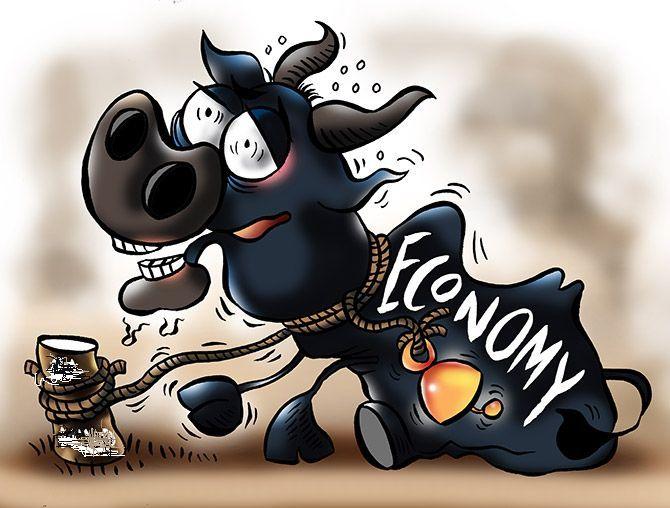 | « Back to article | Print this article |
A look at six indicators shows all of them have collapsed from positive growth in April to contraction in September.
Illustration: Uttam Ghosh/Rediff.com

Finance Minister Nirmala Sitharaman told the Rajya Sabha on Wednesday the country was not in recession yet, and won’t ever be.
A set of data arriving in a day may qualify the statement to some extent.
The Ministry of Statistics and Programme Implementation (MoSPI) will release the data on gross domestic product (GDP) for the July to September quarter of the fiscal year 2019-20 (Q2FY20) on Friday.
Raising slowdown concerns, economists whom Business Standard earlier spoke to have concurred on one thing: The growth in GDP in Q2 would be between 4.2 and 4.7 per cent, slower than the 5 per cent achieved in Q1.
The actual data could be more serious as the lowest-ever quarterly growth clocked since 2012-13 (when the new GDP series began) was 4.3 per cent, in the March quarter of FY13, when India was battling high inflation and political turmoil, in addition to pressures from the global economy.
Representative data for the July-September quarter proves their point to a great extent.
A look at six indicators - imports, exports, rail freight earnings, electricity and diesel consumption, and overall industrial production - shows that all of them have collapsed from positive growth in April to contraction in September.
These indicators are a collage of manufacturing and services sector indicators in the country, encompassing a substantial part of the economy.
While the growth in Q1 was 5 per cent with positive leading indicators, Q2 has been characterised by all indicators in red.
Port traffic too has stagnated, growing 0.4 per cent in the April–October period, entirely brought down by a severe contraction in coal imports.
Growth in consumption of fast-moving consumer goods, such as shampoo sachets and coconut oil, has weakened to 2 per cent in Q2FY20, with the stress concentrated in north Indian states.
Shubhada Rao, chief economist at YES Bank, told Business Standard that except services propelled by the government’s budgetary funding, all the sectors of the economy are a drag on growth in the September quarter.
But she also said that the Indian economy is going through a transition phase, and some near-term impact was expected.
Meanwhile, Sitharaman reiterated in the Rajya Sabha that the efforts to recapitalise public sector banks have paid off, and it is evident in the good liquidity available to finance needy micro, small and medium enterprises.
However, bank credit growth, which had reached 12.2 per cent at the end of FY19, has now fallen back to 8.2 per cent at the end of September.
The GDP growth numbers, due on Friday, would also show how investments in the economy have fared this quarter.
Data from the Centre for Monitoring Indian Economy has shown that India has seen new investments worth only Rs 1.2 trillion in April-September, lowest in absolute terms in the past seven years.
While observers maintain that the slowdown is mainly cyclical in nature, they admit that there are structural reasons too.